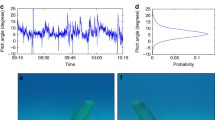Abstract
Goldfish, Carassius auratus, silver dollar, Metynnis hypsauchen, and angelfish, Pterophyllum scalare were induced to swim through narrow vertical and horizontal tubes ranging in length from 0 to 20 cm (approximately 0 to 3 times total fish length, FL). The ability to stabilize the body while negotiating these confined spaces was quantified as (1) the minimum width of vertical (wv) and horizontal (wh) tubes traversed, where width is the smaller cross-sectional dimension of the tube, (2) the ratio wv/wh, and (3) transit speed through the tubes. Tube width was expressed as relative width, obtained by dividing tube width by fish length. Minimum relative widths traversed increased from 0.15 to 0.19 in the order silver dollar > angelfish > goldfish for vertical tubes and from 0.17 to 0.18 in the order goldfish=silver dollar > angelfish for horizontal tubes. wv/wh increased from 0.91 to 1.10 in the order silver dollar=angelfish > goldfish. Minimum tube widths generally increased with tube length for vertical tubes. Although significant differences in relative minimum widths among species were found, these were small. In contrast, for horizontal tubes, there was no significant effect of tube length on minimum tube width for any species. Large differences were found in transit speed. Transit speed generally decreased as the tube length increased. The slope of the relationship between transit speed and tube length varied among species generally increasing from − 0.41 to − 1.16 for horizontal tubes in the order goldfish > silver dollar > angelfish and from − 0.42 to − 1.07 in the order silver dollar > goldfish > angelfish for vertical tubes. As a result, goldfish usually took longest to traverse tubes of zero length but the shortest time to traverse the longest tubes. In contrast, angelfish traversed short tubes in the least time and long tubes in the greatest time. Deeper bodied angelfish swam slowly and traversed tubes with difficulty because they required experience during each trial to replace median and paired fin with body and caudal fin swimming. According to our data, goldfish were best able to swim in confined spaces.
Similar content being viewed by others
References cited
Alexander, R.McN. 1967. Functional design in fishes. Hutchinson, London, 160 pp.
Bandyopadhyay, P.R., J.M. Castano, J.Q. Rice, R.B. Philips, W.H. Nedderman & W.K. Macy. 1997. Low-speed maneuvering hydrodynamics of fish and small underwater vehicles. Trans. ASME 119: 136–144.
Fish, F.E. 1998. Biological designs for enhanced mancuverability: analysis of marine mammal performance. Proceedings of the Symposium on Unmanned Untethered Submersible Technology, Autonomous Undersea Systems Inst., Lee: 109–117.
Moyle, P.B. & Cech, J.J. 1996. Fishes: an introduction to ichthyology. Prentice Hall, Upper Saddle River. 590 pp.
Neter, J., W. Wasserman & M.H. Kutner. 1990. Applied linear statistical models: regression, analysis of variance, and experimental designs. Irwin, Homewood. 1181 pp.
Wainwright, S.A. 1988. Axis and circumference. Harvard University Press, Cambridge. 132 pp.
Webb, P.W. 1998a. Designs for stability and maneuverability in aquatic vertebrates: what can we learn? Proceedings of the Symposium on Unmanned Untethered Submersible Technology, Autonomous Undersea Systems Inst., Lee: 86–108.
Webb, P.W. 1998b. Swimming. pp. 3–24. In: D.H. Evans (ed.) The Physiology of Fishes, 2nd edition, CRC Press, Boca Raton.
Webb, P.W., G.D. LaLiberte & A.J. Schrank. 1996. Does body and fin form affect the maneuverability of fish traversing vertical and horizontal slits? Env. Biol. Fish. 46: 7–14.
Weibs, D. 1989. Design features and mechanics of axial locomotion in fish. Amer. Zool. 29: 151–160.
Weihs, D. 1993. Stability of aquatic animal locomotion. Contemp. Math. 141: 443–461.
Author information
Authors and Affiliations
Rights and permissions
About this article
Cite this article
Schrank, A.J., Webb, P.W. Do body and fin form affect the abilities of fish to stabilize swimming during maneuvers through vertical and horizontal tubes?. Environmental Biology of Fishes 53, 365–371 (1998). https://doi.org/10.1023/A:1007414911734
Issue Date:
DOI: https://doi.org/10.1023/A:1007414911734




